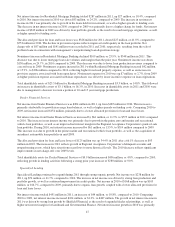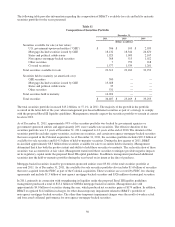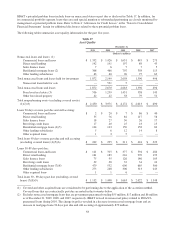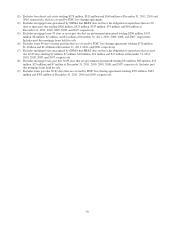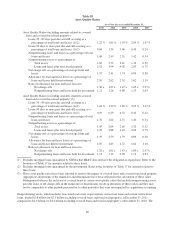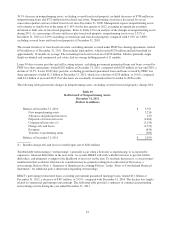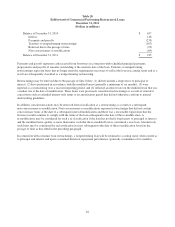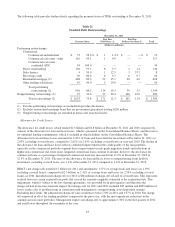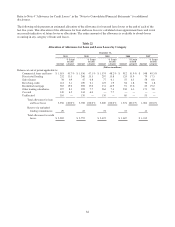BB&T 2011 Annual Report Download - page 57
Download and view the complete annual report
Please find page 57 of the 2011 BB&T annual report below. You can navigate through the pages in the report by either clicking on the pages listed below, or by using the keyword search tool below to find specific information within the annual report.Asset Quality
BB&T has continued to work with its clients that have experienced financial difficulties throughout the economic
recession. During the second quarter of 2010, management implemented a comprehensive nonperforming asset
disposition strategy with a goal of more aggressively reducing BB&T’s exposure to nonperforming loans and foreclosed
properties and to reduce or eliminate any delay in exiting the credit cycle. The strategy was implemented during the
second quarter of 2010 as management believed that pricing for distressed assets had improved. This strategy continued
throughout the third and fourth quarters and into 2011. In the latter part of 2011, management began a more aggressive
approach related to foreclosed properties to further expedite the disposition of its inventory of foreclosed assets.
The implementation of the nonperforming asset disposition strategy included the identification of problem assets that were
transferred from loans held for investment to loans held for sale. In connection with the strategy, management transferred
loans with a book value of approximately $1.9 billion to loans held for sale during 2010. This included $1.5 billion of
commercial loans, which were primarily in the residential, acquisition and development and other commercial real estate
portfolios, and $388 million of residential mortgage loans. Net charge-offs of $605 million were recorded upon transfer to
loans held for sale. This included $141 million related to residential mortgage loans and $464 million for commercial
loans. BB&T also recognized $90 million of losses and additional write-downs related to commercial loans held for sale
during 2010 and an additional $149 million of losses and write-downs in 2011. As of December 31, 2011, the disposition
of all nonperforming commercial loans held for sale was complete. Management also executed an additional sale of $271
million of problem residential mortgage loans in the second quarter of 2011, which resulted in charge-offs of $87 million
when the loans were transferred to the held for sale portfolio.
Substantially all of the loans acquired in the Colonial acquisition are covered by loss sharing agreements with the FDIC,
whereby the FDIC reimburses BB&T for the majority of the losses incurred. In addition, all of the loans acquired were
recorded at fair value as of the acquisition date without regard to the loss sharing agreements. Loans were evaluated and
assigned to loan pools based on common risk characteristics. The fair value of the loans was estimated to be significantly
below the unpaid principal balance. In accordance with the acquisition method of accounting, there was no allowance
brought forward on any of the acquired loans, as the credit losses were included in the determination of the fair value of
the loans at the acquisition date. Charge-offs are recognized for these loans when the actual losses exceed the estimated
losses used in determining the fair value of the loans at the acquisition date. All of the loans acquired in the Colonial
acquisition were considered to be accruing loans as of the acquisition date. In accordance with regulatory reporting
standards, covered loans that are contractually past due will continue to be reported as past due and still accruing based on
the number of days past due.
Given the significant amount of acquired loans that are past due but still accruing, BB&T believes the inclusion of these
loans in certain asset quality ratios including “Loans 30-89 days past due and still accruing as a percentage of total loans
and leases,” “Loans 90 days or more past due and still accruing as a percentage of total loans and leases,” “Nonperforming
loans and leases as a percentage of total loans and leases” and certain other asset quality ratios that reflect nonperforming
assets in the numerator or denominator (or both) results in significant distortion to these ratios. In addition, because loan
level charge-offs related to the acquired loans are not recognized in the financial statements until the cumulative amounts
exceed the original loss projections on a pool basis, the net charge-off ratio for the acquired loans is not consistent with
the net charge-off ratio for other loan portfolios. The inclusion of these loans in the asset quality ratios described above
could result in a lack of comparability across quarters or years, and could negatively impact comparability with other
portfolios that were not impacted by acquisition accounting. BB&T believes that the presentation of asset quality
measures excluding covered loans and related amounts from both the numerator and denominator provides better
perspective into underlying trends related to the quality of its loan portfolio. Accordingly, the asset quality measures in
Table 18 present asset quality information both on a consolidated basis as well as excluding the covered assets and related
amounts. In addition, BB&T has excluded mortgage loans that are guaranteed by the government, primarily FHA/VA
loans, from its asset quality metrics as these loans are recoverable through various government guarantees. Finally, BB&T
has recorded on the balance sheet certain amounts related to delinquent GNMA loans serviced for others that BB&T has
the option, but not the obligation, to repurchase and has effectively regained control. These amounts are also excluded
from asset quality metrics as reimbursement of insured amounts is proceeding in accordance with investor guidelines. The
amount of government guaranteed mortgage loans and GNMA loans serviced for others that have been excluded are noted
in the footnotes to Table 17.
57


